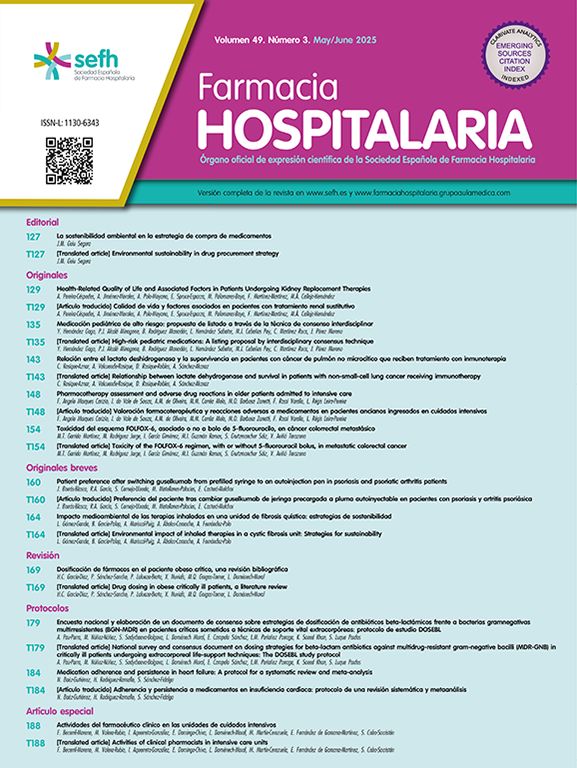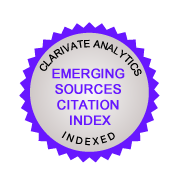Glioblastoma is one of the most aggressive primary brain tumors with the worst prognosis. Few therapeutic options are currently available. Vemurafenib is a kinase inhibitor that demonstrated efficacy in clinical trials for the treatment of tumors with BRAF V600 mutation. Its experience of use in glioblastomas is very limited.
We present the case of a patient diagnosed with BRAF V600 mutated glioblastoma who progressed to standard therapy. After starting treatment with vemurafenib in June 2022, the patient currently maintains a good clinical situation and the disease remains stable, with no progression observed.
DiscussionThere is little literature supporting the efficacy of vemurafenib in BRAF 600 mutated glioblastomas. Published data suggest promising results, although survival in these patients remains low. This patient's progression-free survival is one of the longest documented to date.
el glioblastoma es uno de los tumores cerebrales primarios más agresivos y de peor pronóstico, con escasas opciones terapéuticas en la actualidad. Vemurafenib es un inhibidor de cinasas que demostró eficacia en ensayos clínicos en el tratamiento de algunos tumores con mutación BRAF V600. Su experiencia de uso en glioblastomas es muy limitada.
Se presenta el caso de una paciente con diagnóstico de glioblastoma con mutación BRAF V600 que progresó a la terapia estándar. Tras el inicio del tratamiento con vemurafenib en junio de 2022, la paciente mantiene buena situación clínica y la enfermedad se mantiene estable, sin objetivarse progresión al día de hoy.
Discusiónexiste poca bibliografía que avale la eficacia de vemurafenib en glioblastomas BRAF 600 mutados. Los datos publicados sugieren resultados prometedores, aunque la supervivencia en estos pacientes sigue siendo baja. La supervivencia libre de progresión de esta paciente es una de las más largas documentadas hasta la fecha.
Glioblastoma (GBM) is a histological type of malignant brain tumor of the glioma group. It is known to be one of the most aggressive and fatal types of primary brain tumors. The incidence of this disease is 6 in 100,000, being more common in men. Prognosis is influenced by the presence of genetic and molecular alterations, which guides treatment choice.1,2
First-line treatment for GBM (Stuppe protocol) comprises maximal resection of the lesion followed by radiation therapy and chemotherapy with temozolomide and six cycles of temozolomide. Upon relapse, lomustine has proven modest efficacy. Bevacizumab alone is also used, although without any demonstrated benefits on overall survival (OS).2–4
Vemurafenib is an inhibitor of serine–threonine kinase BRAF that has been demonstrated to be effective for BRAF V600-mutated tumors in clinical trials. This agent is indicated for the treatment of adult patients with unresectable/metastatic BRAF V600-positive melanoma.5 An open, non-randomized, basket, phase II trial (VE-BASKET)6 (n = 122) was conducted to assess the efficacy and safety of vemurafenib in non-melanoma BRAF V600-positive tumors. The study included 24 patients with an age ≥ 16 years; a diagnosis of recurrent glioma (11 with diffuse malignant glioma, of which 6 were GBM); and an ECOG performance status of 0–2. The general median progression-free survival (PFS) was 5.5 months (95% CI: 3.7–9.6), being 5.3 months (95%CI: 1.8–12.9) for the GMD subgroup. The median overall survival (OS) was 28.2 months (95%CI: 9.6–40.1), being 11.9 months (95%CI: 8.3–40.1) for the GBM subgroup.7
Case reportWe present the case of a 50-year-old woman diagnosed with grade IV GBM in December 2021. Molecular analysis was positive for the BRAF V600E mutation and confirmed the absence of MGMT promoter methylation. Final diagnosis was grade-IV GBM, IDH-wild-type, negative for MGMT methylation and positive for the BRAF V600E mutation.
In February 2022, following partial surgical resection, first-line chemotherapy and radiation therapy were initiated with temozolomide 75 mg/m2 + radiation therapy (60 Gy in 30 sessions, from February 2 to March 17, 2022). Then, only a cycle of temozolomide was administered, since disease progression was confirmed on a brain magnetic resonance imaging (MRI) study in May. Administering a local treatment was ruled out by the multidisciplinary committee. Instead, initiating treatment with vemurafenib was considered based on the scientific literature available, the acceptable clinical status of the patient, the presence of the BRAF V600E mutation and the absence of effective therapeutic options.
During the evaluation process and upon confirmation of disease progression on imaging studies, two cycles of lomustine 75 mg/m2 were administered.
Treatment with vemurafenib 720 mg/12 h was initiated in June 2022 and has been maintained to date. The patient currently has an ECOG 1 performance status. The most relevant toxicity is keratosis and viral warts treated by the unit of dermatology. The patient also experienced moderate asthenia, hypersensitivity to light, and blurred vision (ocular alterations associated with chronic corticosteroid use).
The totality of brain MRI studies performed from the initiation of vemurafenib therapy to date demonstrates stable disease (SD) (the latest performed in January 2025).
Currently, the patient is clinically stable, with asthenia as the main adverse event.
DiscussionGBM has an unfavorable prognosis when treated with the standard of care, with a median OS of 14 to 18 months. Particularly, in the case of recurrent GBM, the median PFS with the standard treatment is nine weeks. Of note, second-line therapies have not demonstrated any clinical benefit.7
The presence of mutations guides personalized therapeutic decision-making, resulting in increased survival rates. The incidence of the BRAF V600 mutation in brain tumors varies widely depending on the histological subtype, being very low and hardly detectable in GBM. Notably, only 1–2% of patients diagnosed with GBM are positive for this mutation.8
BRAF inhibitors have been proven to be effective for some types of tumors such as melanoma and lung cancer, which may express oncogenic BRAF mutations. These agents inhibit the RAS/RAF/MEK/ERK signaling pathway, involved in tumor cell growth and proliferation.5,6
The combination of dabrafenib (BRAF inhibitor) and trametinib (MEK inhibitor) for GBM in adults was evaluated in an open, multicenter, basket, phase II trial. The median PFS in the high-grade glioma cohort was 3.8 months (95% CI: 1.8–9.2), with a median OS of 17.6 months (95%CI: 9.5–45.2).9
The efficacy of vemurafenib in recurrent BRAF V600-mutated GBM has not yet been assessed in any clinical trial. However, promising results have been obtained in the VE-BASKET study, albeit survival rates continue to be low. Although the number of patients with GBM included was very low, it can be deemed an adequate sample size, considering the low incidence of the mutation in this type of tumor. Of the 11 patients with GMD, partial response was achieved in a patient; stable disease in five; three patients experienced disease progression (DP); and data are missing for two patients. The longest period with SD was 12.9 months. The study revealed a higher degree of vemurafenib activity in patients with low-grade glioma, as compared to high-grade glioma.7
The multicohort design of this study represents a limitation, as it encompassed tumors with varying histological characteristics, potentially compromising the accurate evaluation of response in patients with GBM. Our results are supported by a previous case report documenting the use of vemurafenib in adult patients with GBM. Zhiying et al. reported the case of a man with recurrent epithelioid GBM who remained with SD for 15 months.10 Due to her clinical status, this patient received vemurafenib alone versus dabrafenib-trametinib or vemurafenib-cobimetinib. Currently, the patient has remained with SD and without DP for 31 months, following the initiation of vemurafenib therapy. To date, this is one of the longest-documented PFS of a patient with GBM treated with vemurafenib. The patient is currently in an acceptable clinical condition, with tolerable toxicity.
The lack of effective therapeutic options and unfavorable prognosis associated with GBM highlight the necessity of pursuing innovative targeted therapies aimed at improving long-term survival in these patients.
CRediT authorship contribution statementIrene de la Fuente Villaverde: Writing – review & editing, Writing – original draft, Project administration, Investigation, Data curation. Alicia Caso González: Writing – review & editing, Writing – original draft, Investigation, Data curation. Mónica Carbajales Álvarez: Writing – review & editing, Writing – original draft, Resources, Data curation. Alba Martínez Torrón: Writing – review & editing, Investigation, Data curation. Sergio Fernández Lastras: Writing – review & editing, Investigation, Data curation. Juan Luis García Llano: Writing – review & editing, Investigation, Data curation. Ana Lozano Blázquez: Writing – review & editing, Validation, Supervision.
AuthorshipIrene de la Fuente Villaverde is the main author and contributed to all processes. Alicia Caso González and Mónica Carbajales Álvarez contributed to the conception and design of the manuscript, data collection and drafting of the case report. Alba Martínez Torrón, Sergio Fernández Lastras and Juan Luis García Llano contributed to data collection and critical review of the manuscript. Ana Lozano Blázquez contributed to the drafting of the manuscript and approved the final version for publication.
FundingThis study did not receive any funding.
The authors declare no conflicts of interest.





